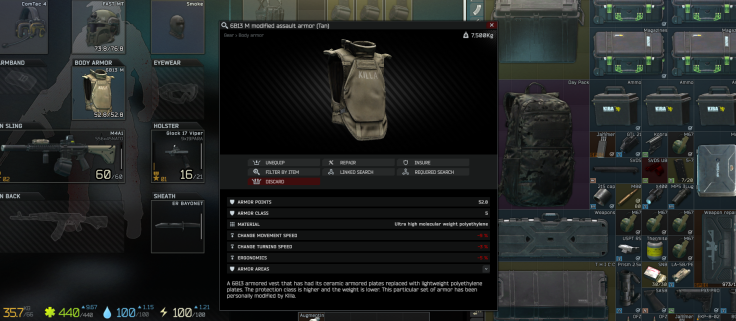'Escape From Tarkov': Armor And Protection Guide
KEY POINTS
- Armor only protects certain parts of the body
- Bullets can ricochet off of helmets if hit at the right angle
- Armor Class dictates the overall defensive capabilities of protective equipment
Having a good set of armor is extremely important for surviving the tense and lethal raids in "Escape from Tarkov." However, picking one armored vest out of the dozens of options can be confusing at first, especially for first-time players who are just getting started.
There are too many vests to choose from in the game so instead of going through each of them, here's an overview of how the armor system works, as well as a few things to keep in mind when building a loadout.
Armor Classes
There are six classes of armor in "Escape from Tarkov," with each having better defensive stats than the previous tier. This dictates the types of rounds that they can protect against and the overall odds of a player surviving gunshots.
Since most useful types of ammunition can easily penetrate the first two classes of armor, any vest or tactical rig under these categories is essentially useless. At the same time, Class Three armor is mostly useful only at the beginning when players don't have access to Ragman LL2.

Ideally, players should at least be using Class Four armor to prevent getting killed instantly by SMG calibers and intermediate assault rifle cartridges.
Class Five armor is arguably the best in terms of cost efficiency as it can block a broader variety of ammunition without having the same price tag as Class Six armor. Additionally, any ammo type that can pierce Class Five can also penetrate Class Six with ease, so there is little point in running top-tier armor for the most part.
Durability and Destructibility
Vests will eventually break when they're shot enough times. Their maximum durability will also get reduced when they are repaired.
Both of these degradation stats are dictated by an armor's material, which can be seen in the Inspect screen. Here are the seven armor material types arranged from least destructible to most fragile:
- Aramid
- UHMWPE (Polyethylene)
- Combined Materials
- Titanium
- Aluminium
- Armor Steel
- Ceramic
UHMWPE and Armor Steel have the best repairability out of all armor materials with Aramid following very closely. Protection will still depend on the armor's class and not their material type.
Glass also exists as a material but it is exclusive to face shields.
© Copyright IBTimes 2024. All rights reserved.





















